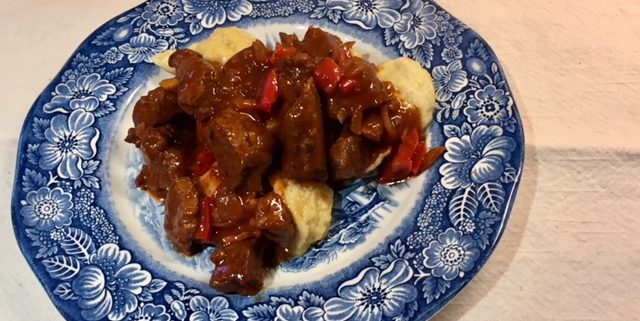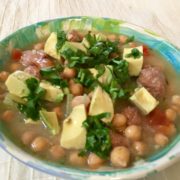Winter Comfort Foods
We headed north to a family cabin in the woods near Bethel, Maine for school’s Winter Break. We usually visit Maine in October when fall is bursting into an extraordinary song of color, a spectacular symphony in red, gold, orange, rust, yellow hues. Fall nights are crisp, days are made for hiking through forests, up and down mountains, alongside lakes in jewel-tone green and turquoise tones, breathing fresh air, a precious opportunity to enjoy nature every minute of the day.
Winter is a different ballgame. I’m from the sunshine valley of Cochabamba after all, and I don’t like being cold! So with trepidation I packed our warmest clothes, and paprika thinking goulash would be on the menu.
Despite my inhibitions about freezing northern winters, there’s a special enchantment in driving through forests dressed pristinely in snow white. With wonder we observed the height of the snow bank as the car took us up the half mile driveway to the cabin, thankful it had been plowed. Otherwise, the cabin would be inaccessible.
Trepidation re-ignited as we tromped through knee-deep snow to the front door, an icy wind biting at my face– the only part of me that was not completely bundled up. Yet once the sturdy wood stove was dutifully at work, exuding delicious warmth into the cabin, the crazy cold and my dislike for it disappeared.
The following days were full or winter sports – cross-country skiing, downhill skiing, and snow-shoe trekking making for rosy cheeks, happily tired muscles, and hearty appetites. The vigorous exercise and the sensation of breathing fresh cold air deep into my lungs did away with angst and discomfort of cold weather. That and coming back to the comfort of the warm wood stove, of wholesome ingredients going into pots and oven to make delicious, nutritious meals.
I was inspired by Real Food: What to Eat and Why by Nina Planck who grew up on homemade scratch cooking on a family farm, became a vegan in early adulthood and made a full circle back to real foods; foods that are traditional, “the way we used to eat them” — local, seasonal fruits and vegetables, whole grains, unrefined fats and oils. Real food produced and prepared the old-fashioned way from farm to table.
[su_expanding_quote_book source_author=”Nina Planck” source_title=”Real Food: What to Eat and Why” full_quote=” At my house and at the farm, we eat the way people did for thousands of years. That means red meat, whole milk, butter and raw milk cheeses. But the beef and milk are grass-fed, the pork and poultry are pastured and the fats –from lard to coconut oil – are unrefined. Milk, cream, and butter are grass-fed and raw. Foods should be eaten with the fats they come with.The story about diet and disease is more complicated than saturated fats and cholesterol. Traditional diets are rich in many other nutrients that prevent heart disease, including omega-3 fats in fish and B vitamins. The experts are right: our diet is killing us. But traditional beef, butter, and eggs are not to blame for obesity, diabetes, and heart disease. The so-called diseases of civilization are caused by the foods of civilization. More accurately – the diseases of industrialization are caused by the foods of industrialization.” short_quote=”At my house and at the farm, we eat the way people did for thousands of years. That means red meat, whole milk, butter and raw milk cheeses. But the beef and milk are grass-fed, the pork and poultry are pastured and the fats are unrefined.”Our first dinner at the cabin was a proper roasted chicken, something I’d never done before. I’ve avoided chicken skin for years, maybe decades. But Nina Planck made me rethink my choice based on new information. Not all chicken is created equal. I’ve written before about avoiding factory-farmed animals for humane, environmental reasons and health reasons, but I’m only now learning about the significan different quality of sustenance and nutrition between family-farm chicken and Tyson/industrial chickens.
[su_expanding_quote_book alignment=”left” source_author=”Nina Planck” source_title=”Real Food: What to Eat and Why” full_quote=”Chicken fat is monounsaturated and polyunsaturated – two fats even conventional experts say are healthy. Chickens raised on grass contain more conjugated linoleic acid (CLA), an unusual fat that fights cancer and builds lean muscle. Chicken fat also boosts immunity.” short_quote=”Chicken fat is monounsaturated and polyunsaturated – two fats even conventional experts say are healthy. “]Here’s my week’s menu. Let me know if you give it a try! Either in its entirety or a recipe or two. I find much of the effort of making homemade dinner is thinking and planning what to make, what to eat it with, making the grocery list and having the proper ingredients. A menu plan simplifies the effort and process.
This menu is provides four servings per meal, this generally gives me enough leftovers (we’re a family of two adults and one child) to make into another dinner. Or to simply eat leftovers for lunch. I recommend making a double recipe to jumpstart a second meal.
One of the key reasons I started this blog was to alleviate some of that brainwork and make it easier for others to make delicious, nutritious meals from scratch.
Please do let me know if you find this menu helpful. If not, how can it be more useful?
Saturday
Epicurious: Simple Roasted Chicken with Cauliflower Mashed Potatoes and Mushrooms, Greens and Apple Salad with Walnuts.
To the roasting pan added 1 cauliflower cut into 4 sections and 2 russet potatoes (scrubbed and poked all over with a fork).
While the chicken, cauliflower and potatoes were roasting, I sliced 8 oz of mushrooms and 1 medium onion. I warmed up 1 tablespoon butter and 1 tablespoon extra-virgin olive oil and sautéed the onion and mushrooms until the mushrooms were dark and almost crispy on the edges
I also made the salad while the chicken was in the oven.
When the chicken was done, I removed it from oven and let it rest 10 – 15 minutes. Meanwhile, coarsely chopped cauliflower and potatoes, put them into a medium pot and mashed with a potato masher. Added milk until it had the consistency I wanted, seasoned with salt and pepper to taste and warmed it up on the stove top.
Cut up the chicken and served it with the Cauliflower Mashed Potatoes alongside topped with the sautéed mushrooms.
After dinner, I cut all the remaining meat from the chicken, put the cut-up chicken into a storage container in the refrigerator. Then I put the chicken bones into a pot with 2 chopped onions, 2 celery stalks, 2 medium carrots, 4 garlic cloves, a handful of fresh rosemary, salt and pepper. Covered, brought to a boil, reduced heat and simmered for 30 – 40 minutes. When cool, strained the broth and put into storage container in the refrigerator.
Sunday
Breakfast: Apple slices. Ginger carrot oatmeal.
Dinner: Epicurious: Hearty Goulash Soup I skipped the potatoes and reduced the broth to 2 cups to make a stew instead of soup and served the goulash with spaetzle. My family loves loves loves these traditional Austrian dumplings, but the dumplings are not necessary. The goulash can be served with buttered noodles, usually the extra-wide egg noodles but I’ve also used bow-tie or large macaroni. Or, just make the recipe as is, a hearty, filling soup.
I made a salad of spinach, micro greens and 1 cup defrosted frozen peas tossed with some CMF Basic Salad Dressing
Monday
Breakfast: Bacon and eggs with toast, smoothie of almond milk and frozen berries (If desired, cook extra bacon for Pasta and Cauliflower Alfredo Sauce later in the week. After breakfast coarsely chop it up and store in the refrigerator in a covered container.)
Dinner: African Coconut Soup. Salad of arugula mixed 1 apple cut into matchsticks and 2 grated carrots. Optional, add 2 – 4 tablespoons of toasted nuts or seeds (pumpkin, sunflower)
Tuesday
Breakfast: Apple slices. Oatmeal with berries (add 1 cup frozen berries the last 5 minutes that the oatmeal is cooking)
Dinner: Epicurious: Sausage and Lentils
I used Italian turkey sausage and skipped the mushrooms this time since put mushrooms in my Cauliflower Mashed Potatoes earlier this week. This recipe makes 6 servings leaving leftovers to make Sheppard Pie another night using the leftover Cauliflower Mashed Potatoes
Wednesday
Breakfast: Grapefruit (I peel, remove membrane and put into a bowl.) Or orange slices. Soft-boiled eggs and toast.
Dinner: Pasta with Cauliflower Alfredo Sauce
Cook pasta in boiling water. Meanwhile, puree roasted cauliflower reserved on Saturday with 1 cup (or more depending on preferred consistency) chicken broth. If there are no leftover sautéed mushrooms, sauté 1 finely sliced medium onion with 5 oz of spinach (or 1 sliced red bell pepper).
Drain cooked pasta, toss with cauliflower Alfredo sauce, and leftover chicken.
Variations:
- Mix in leftover chicken
- Mix in leftover bacon
- Mix in leftover sautéed mushrooms
Thursday
Breakfast: Grapes. Apple Pie Oatmeal
Dinner: Sheppard Pie with leftover Sausage and Lentils and Cauliflower Mashed Potato. Served with Spinach Citrus Salad
Other Winter Comfort Dishes to anchor a weekly menu on:
Use chili leftovers to make Sheppard Pie, or heat up and serve nacho-style over roasted sweet potato rounds topped with plain yogurt and chopped cilantro
Or toss leftovers with whole-wheat spaghetti
Epicurious: Polenta with Meat Ragu. Double the meat ragu. Make a second meal by placing ragu inside spaghetti squash, butternut or acorn squash (cut in half, seeds removed) and roast in oven for 30 minutes or until squash is tender.
Or scoop it into in baked sweet potatoes
Epicurious: Pork Cassoulet. Cassoulet evolved over centuries in the countryside of southwest France, a peasant dish of meat and beans, changing with ingredients (pork, duck, sausage…) on hand.
Use the leftovers to make a Sheppard Pie for a second dinner later in the week
Pork Pork Tenderloin with Butternut Squash Mac and Cheese
Make Butternut Squash and Ginger Soup one or two days before, roasting twice the amount of butternut squash needed. Serve Butternut Squash Soup with goat cheese toast, and Kale Salad with Cranberries.
Use leftover roasted butternut squash to prepare Butternut Squash Mac and Cheese. I do this the night before for a busy weeknight. Then all I have to do it put the Pork Tenderloin into the oven and toss a quick green salad.
I slice the leftover pork tenderloin thinly and use for sandwiches, wraps or salads (cutting sliced pork into strips) later in the week.





Leave a Reply
Want to join the discussion?Feel free to contribute!